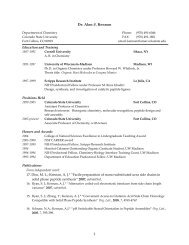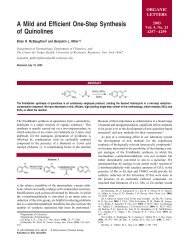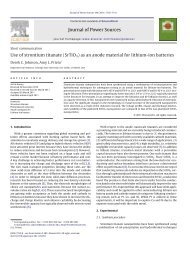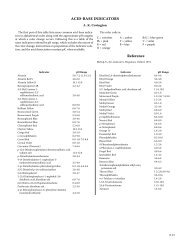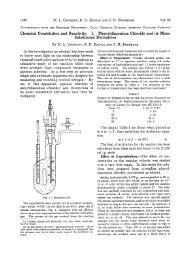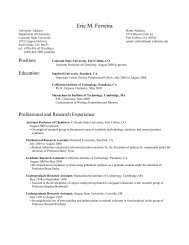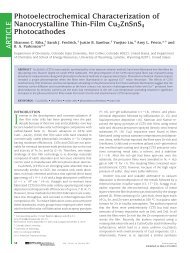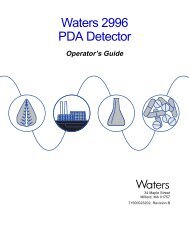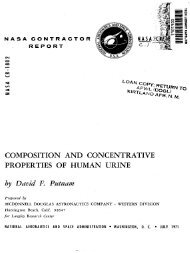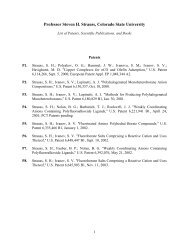Message from the Chair - Department of Chemistry - Colorado State ...
Message from the Chair - Department of Chemistry - Colorado State ...
Message from the Chair - Department of Chemistry - Colorado State ...
Create successful ePaper yourself
Turn your PDF publications into a flip-book with our unique Google optimized e-Paper software.
Happenings<br />
Nobel Laureate Ei-ichi Negishi to Present Boulder Scientific<br />
Lecture at CSU<br />
<strong>Chemistry</strong> is honored to present Pr<strong>of</strong>essor Ei-ichi Negishi, Nobel<br />
Laureate and Pr<strong>of</strong>essor <strong>of</strong> <strong>Chemistry</strong> at Purdue University, as <strong>the</strong> Boulder<br />
Scientific Distinguished Lecturer on December 6, 2011.<br />
Negishi was born on July 14, 1935 in Changchun, China, as<br />
a Japanese citizen. His family moved to Harbin when he was one and <strong>the</strong>n<br />
to Seoul, Korea, two years before <strong>the</strong> end <strong>of</strong> World War II. Shortly after <strong>the</strong><br />
end <strong>of</strong> World War II in 1945, his family returned to Japan and moved into<br />
a house in Tokyo which his parents had purchased several years earlier that<br />
miraculously survived many intensive bombings.<br />
Negishi entered Tokyo University and graduated in 1958 with a<br />
bachelor’s degree in Engineering. He <strong>the</strong>n worked as a research chemist<br />
at <strong>the</strong> Iwakuni Research Labs, which was <strong>the</strong> main research facility <strong>of</strong> Teijin<br />
Co. He won a Fullbright-Smith-Mund Scholarship in 1960 and entered<br />
graduate school at <strong>the</strong> University <strong>of</strong> Pennsylvania and obtained his PhD<br />
degree in just three years under Pr<strong>of</strong>essor A.R. Day. In 1966, he joined<br />
H.C Brown’s laboratory as a post-doc for two years and <strong>the</strong>n stayed four<br />
more years as Pr<strong>of</strong>. Brown’s assistant and an instructor. During his tenure<br />
in <strong>the</strong> Brown laboratory, he worked mainly in <strong>the</strong> area <strong>of</strong> organoboron<br />
chemistry. He <strong>the</strong>n moved to Syracuse University in 1972 to start his<br />
independent career as an Assistant Pr<strong>of</strong>essor and it was that year, that<br />
Pr<strong>of</strong>. Robert M. Williams <strong>of</strong> <strong>the</strong> CSU <strong>Chemistry</strong> <strong>Department</strong> joined his<br />
laboratory as an undergraduate research assistant. After achieving tenure,<br />
Ei-ichi Negishi receiving his Nobel Prize <strong>from</strong> His<br />
Majesty King Carl XVI Gustaf <strong>of</strong> Sweden at <strong>the</strong><br />
Stockholm Concert Hall, December 10, 2010.<br />
Negishi was quickly recruited back to Purdue in 1979 where he has remained ever since and is currently <strong>the</strong> H.C. Brown<br />
Distinguished Pr<strong>of</strong>essor <strong>of</strong> <strong>Chemistry</strong>.<br />
It was at Syracuse that Negishi first branched out into transition metal chemistry, leading to his interests in transition<br />
metal-catalyzed cross-coupling reactions that eventually evolved into his discovery <strong>of</strong> <strong>the</strong> zinc-based palladiumcatalyzed<br />
cross-coupling reaction for syn<strong>the</strong>sizing stereo-defined alkenes. This reaction is now known as <strong>the</strong> “Negishi<br />
Cross-Coupling Reaction”. He also discovered a zirconium-catalyzed carboalumination reaction and several o<strong>the</strong>r important<br />
transition metal-catalyzed processes. His work has been recognized with many accolades, <strong>the</strong> most noteworthy <strong>of</strong><br />
which are <strong>the</strong> Chemical Society <strong>of</strong> Japan Award (1997), ACS Award for Organometallic <strong>Chemistry</strong> (1998), <strong>the</strong> Yamada-Koga<br />
Prize (2007), ACS Award for Creative Work in Syn<strong>the</strong>tic Organic <strong>Chemistry</strong> (2010) and <strong>the</strong> Nobel Prize in <strong>Chemistry</strong> (2010).<br />
The 2010 Nobel Prize in <strong>Chemistry</strong> was “for palladium-catalyzed cross couplings in organic syn<strong>the</strong>sis" and was<br />
shared between Pr<strong>of</strong>. Negishi, Richard F. Heck (University <strong>of</strong> Delaware), and Akira Suzuki (Hokkaido University, Japan). It is<br />
vitally significant to recognize that <strong>the</strong> late John K. Stille, University Distinguished Pr<strong>of</strong>essor in <strong>the</strong> CSU <strong>Chemistry</strong> <strong>Department</strong><br />
who was killed on United Airlines flight 232 in Souix City, Iowa in 1989, had also developed a highly cited and widely<br />
used palladium-catalyzed cross-coupling reaction involving organotin compounds that bears his name. Had Pr<strong>of</strong>. Stille survived,<br />
many chemists believe that he would have shared <strong>the</strong> Nobel Prize with Pr<strong>of</strong>. Richard F. Heck, who pioneered this<br />
field, and one <strong>of</strong> <strong>the</strong> o<strong>the</strong>r two Japanese Nobel laureates.<br />
- Thanks to Pr<strong>of</strong>. Robert M. Williams, CSU University Distinguished Pr<strong>of</strong>essor




